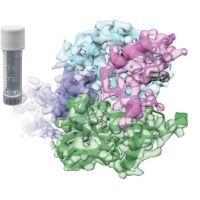Specification
| Description | Recombinant protein from the full-length sequence of Homo sapiens Fas associated factor 1 (FAF1) (NM_007051). |
| Organism | Homo sapiens (Human) |
| Expression Host | Human Cells |
| Tag Info | His or DYKDDDDK. Please contact us if you need further information or require specific designed tag. |
| Purity | Greater than 90% by SDS-PAGE gel |
| Uniprot ID | Q9UNN5 |
| Entry Name | FAF1_HUMAN |
| Gene Names | FAF1 UBXD12 UBXN3A CGI-03 |
| Alternative Gene Names | UBXD12 UBXN3A |
| Alternative Protein Names | FAS-associated factor 1 (hFAF1) (UBX domain-containing protein 12) (UBX domain-containing protein 3A) |
| Application | Antigens, Western, ELISA and other in vitro binding or in vivo functional assays, and protein-protein interaction studies; For research & development use only! |
| Buffer | Purified protein formulated in a sterile solution of PBS buffer, pH7.2, without any preservatives |
| Endotoxin | Endotoxin level is < 0.1 ng/µg of protein (<1EU /µg) |
| Length | 650 |
| Molecular Weight(Da) | 73954 |
| Protein Sequence | (The sequence of expressed protein may have some variation from the sequence shown below. Please contact us for the exact sequence.) MASNMDREMILADFQACTGIENIDEAITLLEQNNWDLVAAINGVIPQENGILQSEYGGETIPGPAFNPASHPASAPTSSSSSAFRPVMPSRQIVERQPRMLDFRVEYRDRNVDVVLEDTCTVGEIKQILENELQIPVSKMLLKGWKTGDVEDSTVLKSLHLPKNNSLYVLTPDLPPPSSSSHAGALQESLNQNFMLIITHREVQREYNLNFSGSSTIQEVKRNVYDLTSIPVRHQLWEGWPTSATDDSMCLAESGLSYPCHRLTVGRRSSPAQTREQSEEQITDVHMVSDSDGDDFEDATEFGVDDGEVFGMASSALRKSPMMPENAENEGDALLQFTAEFSSRYGDCHPVFFIGSLEAAFQEAFYVKARDRKLLAIYLHHDESVLTNVFCSQMLCAESIVSYLSQNFITWAWDLTKDSNRARFLTMCNRHFGSVVAQTIRTQKTDQFPLFLIIMGKRSSNEVLNVIQGNTTVDELMMRLMAAMEIFTAQQQEDIKDEDEREARENVKREQDEAYRLSLEADRAKREAHEREMAEQFRLEQIRKEQEEEREAIRLSLEQALPPEPKEENAEPVSKLRIRTPSGEFLERRFLASNKLQIVFDFVASKGFPWDEYKLLSTFPRRDVTQLDPNKSLLEVKLFPQETLFLEAKE |
Background
| Function | FUNCTION: Ubiquitin-binding protein (PubMed:19722279). Required for the progression of DNA replication forks by targeting DNA replication licensing factor CDT1 for degradation (PubMed:26842564). Potentiates but cannot initiate FAS-induced apoptosis (By similarity). {ECO:0000250|UniProtKB:P54731, ECO:0000269|PubMed:19722279, ECO:0000269|PubMed:26842564}. |
| Pathway | |
| Protein Families | |
| Tissue Specificity | Most abundant in testis, slightly less abundant in skeletal muscle and heart, followed by prostate, thymus, ovary, small intestine, and colon. Not detected in the peripheral blood leukocytes. {ECO:0000269|PubMed:10462485}. |
QC Data
| Note | Please contact us for QC Data |
| Product Image (Reference Only) |  |

